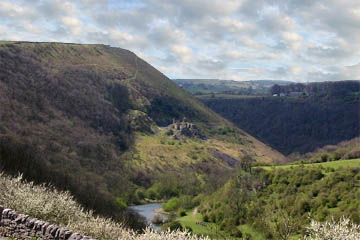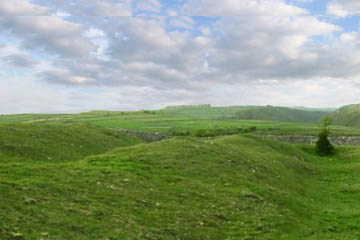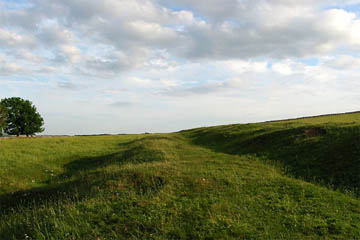The Dead Woman of Fin Cop Hill
| 53 14 08.26N 1 44 22.55W | Fin Cop Hill Fort | The hill fort runs north to south, but only on the eastern side are the ramparts clearly visible within the light green of the modern fields. The northern and western ramparts are less easy to make out. |

|
| Fin Cop Hill overlooks the River Wye as it winds through Monsal Dale. |
For as long as anyone could remember, Fin Cop hill in the English Peak District, was marked by a huge cairn, 160' in circumference and correspondingly high. In 1795 a local farmer realised that there was a market for limestone that could be rendered down for cement or used to build walls around his fields. Digging up the limestone that forms the Peak District was hard work, but the huge heap of limestone blocks was there for the taking. Next market day he hired a band of workmen to come and haul the stones away.
Fortunately a nearby antiquarian, Mr Hayman Rooke, overheard one of the workmen talking about his new job. Rooke had no authority to stop the farmer's vandalism but he was able to persuade the farmer to suspend operations while he investigated the mound. Archaeology had not yet been invented and Rooke's investigation would today be considered little better than grave robbing, nevertheless he worked with commendable care and produced a detailed report on what he found.
Beneath the huge pile of stones Rooke found two small stone-lined holes known as "cists", one of which was covered with a slab of black Ashford Marble, a fine limestone brought from some distance away. Inside each cist was a skeleton buried face down. Beside the cists were three large jars that we now identify as Bronze Age, filled with ashes and burned bones - the remains of cremations. There were no bronze implements, but buried with the bodies were a couple of flint arrowheads and a flint spearhead.
Fortunately the sale of the limestone did not bring in as much as the greedy farmer had hoped, and he left a second cairn alone. In the 1920s a certain Major Harris, who was interested in ancient history, surveyed the whole area and identified the cairn which was hidden by a circle of trees. With the permission of the land owner he excavated the cairn using techniques little in advance of those employed by Hayman Rooke. He found a single cist containing a skeleton, but surrounding it were the remains of another thirty bodies. There was no government body to care for such discoveries and when a doctor at nearby Bakewell expressed an interest in his work, Major Harris gladly presented him with one of the skeletons, which was displayed in the surgery for many years - though whether as an example in anatomy or history is not known.
In the 1940s the author Nellie Kirkham wrote about the Peak District and reported her observations on Fin Cop, where she noted several rows of ramparts which are not visible today (and may have been nothing more than her vivid imagination). Of greater value was her observation that Neolithic flint tools had been found on the site. Modern investigations have shown that humans were active in the area from the Mesolithic Period and used nearby caves as homes and burial places.

|
| The eastern ramparts of the hill fort are the best preserved. |
Between 1965 and 1969 the University of Manchester conducted extensive field surveys in the area, in which archaeology students walked over the hills in a systematic manner, noting everything they found. On Fin Cop they identified eight house platforms and picked up pottery sherds which dated them to the Late Bronze/Early Iron Age. A bit of grubbing in the dirt revealed a few pieces of charcoal which were taken back to the university and carbon dated. The results were far from precise - 1700-950 BC - but confirmed the evidence of the pottery. On the assumption that the houses pre-dated the need for a fort, the Manchester study concluded that the fort itself dates to the early Iron Age.
That means that the fort was built around the two huge burial mounds, a fact which rather disproves New Age theorising about sacred spaces and ley lines and other such nonsense. Either the fort builders were unaware of the true nature of the mounds - which seems unlikely - or they were not in the least uncomfortable about living in close proximity to them. As the ten acres enclosed by the fort ramparts makes it one of the largest forts in the Peak District, it is unlikely that there were only eight houses. Its prominent position on a steep slope overlooking Monsdale and the River Wye gave it good defensive advantages to north and west, and although the approach is nearly flat to south and east, the substantial rampart, topped by a stone wall and with a deep ditch in front of it, gave adequate protection from enemies.
The only entrance to the fort was in the east, where a large gateway, flanked by two towers, was closed by a wooden gate. Ground cleared for agriculture or grazing gave ample time for an approaching enemy to be detected, the gate hauled shut and the walls manned. Nevertheless, sometime in the 4th or 3rd centuries BC something disastrous happened at Fin Cop fort.
In July 2009 the Longstone Local History Group organised a small excavation of the fort under the direction of Dr Clive Waddington. Volunteers and local school children took part in the digging which consisted of a number of pits in a line across the centre of the fort and two trenches, one of which cut through the well-preserved eastern rampart.

|
| Another view of the eastern ramparts of the hill fort. |
Although the digging was conducted with painstaking care, the work wasn't all that difficult, for on these heights the depth of soil was small. Rock lay only a few inches beneath the grass and only where the rock had been cut away to form the ditch did the excavation go down more than a foot or so. The results were impressive, for they showed that the wall was made of a strong stone wall behind which was a sloping ramp of rubble and clay. Given the remaining height of the rampart and the amount of worked stone that had been tumbled into the ditch, the excavators estimate that the walls were 10' high - and as at least some stone has been robbed, the walls may have been even higher.
Of course, on the summit of these hills the weather is not at kind and centuries of wind, rain, snow and ice were quite sufficient to account for the present ruinous state of the wall and the excavators just assumed that the walls had gradually fallen, one stone after another being slowly dislodged to slide and roll down into the ditch. It was as the excavation was nearing its end that they found evidence to contradict this assumption.
The ditch had been cut into the natural bedrock - the stones of the wall had, by and large, come from the ditch - and over the years wind and rain carried a thin layer of soil into the ditch and covered the bedrock. At the very edge of the excavation trench the workers spotted something different among the tumbled stones - a bone. Careful work and the lifting of several stones uncovered a nearly complete skeleton. Someone had been buried beneath the fallen wall.
Unlike other burials, where the body is laid out carefully, limbs neatly arranged, this body appeared to have been dropped into the ditch. The head was twisted to the right and the arms trailed as if the body was in the recovery position, but the legs were curled up under the chest. The legs were lower down than the head: it was as if someone had taken the body by the arms and dropped it from the wall into the ditch and the body had collapsed like a puppet whose strings were cut.
The excavators sent for experts who quickly identified the body as that of a young woman, between 20 and 30 years of age. The same experts also discovered that there were three scapulae, one very much smaller than the other. It appeared that the woman had been in the last stages of pregnancy when she died.
The fact that the bones were found together rather than scattered by weather or the depredations of wild animals indicated that she had been buried rather than simply discarded in the ditch - but all that buried her were the tumbled stones of the wall! In other words, whoever tossed her body into the ditch had then deliberately demolished the defences of the fort and covered her with the stones of the dismantled wall.
Jim Brightman, one of the project managers, said: "Quite a lot of very important finds cannot look like much on site, but when you get back to the lab and throw the scientific techniques and analysis at them, that's when you start to get the story out. The bones are a great example of that, we found out so much more by analysing them."
Was this an isolated atrocity or do the fallen ramparts conceal many other bodies? Are we dealing with a single murder or the complete genocide of the people of Fin Cop fort? Only further excavation can reveal the answer and Longston Local History Group have now received a grant from the Lotteries Heritage Fund of nealry £50,000 to fund another season of digging. It is possible that the tragic find and the interest it aroused played their part in loosening the Lottery's notoriously tight pockets.
There is, however, one fact that may point to a massacre rather than a murder.
When the Romans invaded Britain two centuries after this tragedy they were very active in the Peak District because of the presence of lead ore. Many Roman lead mines and their associated works and settlements have been identified. There is evidence of a trial dig on Fin Cop, but presumably the hoped-for lead did not appear and the Romans lost interest. The only evidence of their presence is a single Roman coin that was reported to be found here, but the coin was never identified and its present location is unknown. However there was a settlemet at Brushfield on the opposite side of the valley. Does this indicate that the hill fort was uninhabited and abandoned by the time the Romans arrived?
the farmer's vandalism The National Farmers' Union makes big play of the claim that farmers are "guardians of the countryside", a bit of hyperbole that brings a grim smile to the lips of anyone other than a farmer who has anything to do with Britain's countryside. The average farmer might not sell his grandmother if the price was right, but short of that he will root up hedges, demolish antiquities, pollute the rivers, grow Frankenfoods (genetically modified crops) and treat his animals with careless cruelty without turning a hair. There may be farmers who have a responsible attitude towards the countryside, but they are pretty thin on the ground. They are, of course, no worse than industrialists, but industrialists make no claims to being "guardians of the countryside". Return
© Kendall K. Down 2010





